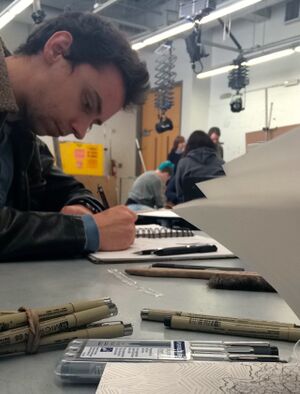Resource:Creating How To Contribute To An Existing Course And Transform A Traditional Classroom Into A Mini Maker Space
Contents
Introduction
Many traditional courses within higher education are quickly becoming obsolete, outdated, or irrelevant to a student's aspirations and educational toolkit. As many industries and markets demand cutting-edge innovation, the question must be asked "where can such skills and knowledge be gained?" Makerspace's have gained significant traction in recent years, and we are quickly seeing them being adopted into academia across the nation. While every classroom has space for improvement, why are more classes not implementing such phenominal programs that give students real-world skills that can transfer into their careers after graduation?
Need and Goals
When it comes to bringing others into a creative space, it’s important to remember there are more than just monetary needs. As understood from previous members of UIF, there can be much beauracracy to cut through in the institutionalized academic landscape in addition to many skeptics whom traditionally are risk-averse.
The most important thing to trasition a traditional course into a mini makerspace is teaming up with faculty and staff whom are fully supporting the vision. This alliance changes the rules as budgets can be larger, changes be made more quickly, and doors are opened that would otherwise be inaccessible. Having a rough idea or vision is great to keep the spirit alive and going; however, overplanning and rigidness quickly can ruin potential opportunities. The general consensus is to have broad goals, yet remain flexible enough to iterate when appropriate.
Academic Permission
Being backed by key faculty and staff can drastically alter the outcome of your efforts. Ideally, the higher, the better. Including prominent figures whom are associated with your university, such as an academic dean, are able to do a significant amount in small amounts of time. Be sure to collaborate with as many faculty and staff who express an interest as this gains interia and means greater access to funding and clearance to make the necessary changes.
Support
A crucial portion of support comes from the faculty, teachers, the board of trustees and alumni. These people are not merely resources, but people who care and are onboard with a given idea and are ready to help for the good of the cause. Creating innovate spaces and area with easy communication is not a one man job; Innovation involves solid support and feedback.
Cost
This will depend on your university and their policies. A basic, mini makerspace can be very inexpensive (as little as $700) while giving the most basic tools and supplies to accomplish simple prototyping. With greater sophistication of the supplies in addition to the space being used, costs can see an exponential rise. Recommendations for reducing costs include; piggybacking off of pre-existing makerspaces, collaborating different colleges/departments within your university, and getting supplies donated from larger corporations.
Location
This can differ depending on the size of your class and your classes needs. It is important to work with the academic dean and registrar in order to make sure your needs are met and an appropriate classroom is acquired. A main focus should be to promote the makerspace as a supplimentary facet of the class, rather than an entirely own project.
Activities
The point of a makerspace is to foster the creativity in people so activities should revolve around that goal. You should give the class a project like designing a better shopping cart and see what they come up with. Periodically you should hold design review sessions to provide a different view and give constructive advice.
Materials
Materials needed vary from one place to another but a big fancy lab is not needed. Basic office supplies such as sharpies, post it notes, and space will start you off. Your main goal is to foster creative and you don't need a ton of supplies to do that. One thing to keep in mind when you start a project like this is that it will require a lot of time to put together.
Management
It is important to make sure that you stay in contact and update all groups involved. The more aware the groups involved in this project are the better prepared you will be to tackle challenges.
Lessons & Tips
There are a lot of groups involved in this process and it is is important to understand all parties goals, in order to make this successful. This process can be extremely time consuming, so it is important to plan accordingly and expect what you put in is what you are going to get out of it.
Community Support
It is important to get the community involved with the entire process of creating a makerspace. Getting the community around the University to help promote and support the students makes everything run smoother and easier. As with everything else in the world, networking speeds up and enhances everything people do. Bringing community business’ into or at least in the same facility as the students really makes the setting feel real. Working around real businesses do two things. It opens up other resources to students and it also allows students to learn from their mistakes and accomplishments.
